VCT2 Offline Voice Module Datasheet
Last Updated on : 2025-07-10 02:14:15download
Product overview
VCT2 is a high-performance and low-cost offline voice recognition module that Tuya has developed. It consists of a highly integrated voice recognition chip CI1102, an external flash memory, an audio amplifier, and a peripheral power chip. The module is built-in with the Neural Network Processing Unit BNPU which supports large-scale local voice recognition. It can serve various types of smart voice solutions with the built-in CPU.
The architecture of the module is shown below:
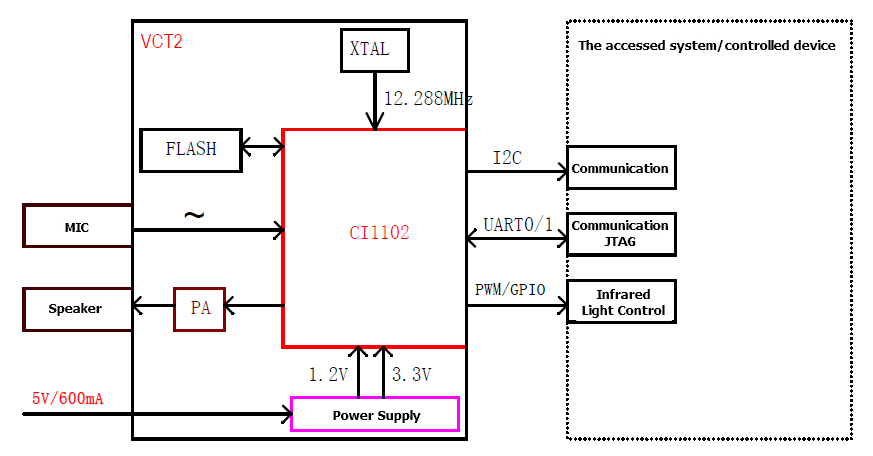
Features
- Small size, suitable to be integrated into various overall units
- Low power, ≤150mW during operation, applicable to products that have the energy consumption requirements and battery-powered products
- Low cost and high cost performance. VCT1 is a dedicated voice recognition module for the Artificial Neural Network (ANN) in the industry.
- High performance. The single microphone solution achieves the super high recognition rate, super long distance recognition, single-microphone noise reduction, and single-microphone echo cancellation.
- Good expansibility. Extend IoT modules (such as Wi-Fi, Zigbee and Bluetooth LE) through I2C to achieve networking.
- Rich interfaces including UART, PWM, and ADC.
Applications
- Smart home products that can be controlled independently
- Voice interfaces for hotel and real estate
- Entertainment and toys
Module interfaces
Dimensions and footprint
VCT2 has 2 lines of pins, 20 pins in total, with a spacing of 2.0 mm.
The VCT2 dimensions are 22 mm (L)×24 mm (W) ×3 mm (H), which are shown below:
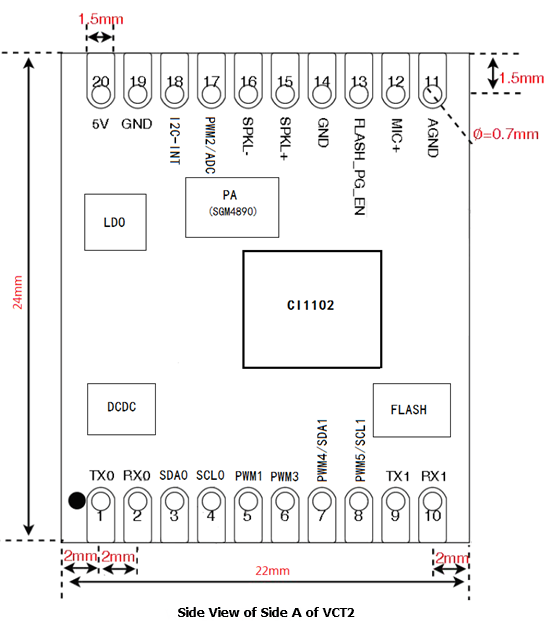
Interface definitions
The module pins and their functions are shown below:
| Pin number | Pin name | Type | Driving capability | Default state when powered on | Function |
|---|---|---|---|---|---|
| 1 | TX0 | I/O, T+U | 4 mA | IN, T+U | 1. UART0_TX; and 2. GPIO 0 |
| 2 | RX0 | I/O, T+U | 4 mA | IN, T+U | 1. UART0_RX; and 2. GPIO 1 |
| 3 | SDA0 | I/O, T+D | 4 mA | IN, T+D | 1. I2C0-SDA; and 2. GPIO 2 |
| 4 | SCL0 | I/O, T+D | 4 mA | IN, T+D | 1. I2C0-SDA; and 3. GPIO 2 |
| 5 | PWM1 | I/O, T+D | 4 mA | IN, T+D | 1. PWM [1]; and 2. GPIO 16 |
| 6 | PWM3 | I/O, T+D | 4 mA | IN, T+D | 1. PWM [3]; and 2. GPIO 18 |
| 7 | PWM4 | I/O | 4mA | IN, T+D | 1. PWM 4; 2. GPIO 19; 3. I2C1_SDA |
| 8 | PWM5 | I/O | 4 mA | IN, T+D | 1. PWM 5; 2. GPIO 20; 3. I2C1_SCL |
| 9 | TX1 | I/O, T+U | 4 mA | IN, T+U | 1. UART1_TX; and 2. GPIO 23 |
| 10 | RX1 | I/O, T+U | 4 mA | IN, T+U | 1. UART1_RX; and 2. GPIO 24 |
| 11 | AGND | P | - | - | Analog ground |
| 12 | MIC+ | - | - | - | Microphone positive |
| 13 | PG_EN | I/O, T+D | 4 mA | - | 1. FLASH_PG_EN, enter the UART upgrade mode when the module is pulled to 3.3V; 2. GPIO 31 |
| 14 | GND | P | - | - | Signal ground |
| 15 | SPK+ | - | - | - | Speaker |
| 16 | SPK- | - | - | - | Speaker |
| 17 | PWM2 | I/O | 4 mA | IN, T+D | 1. PWM 2 output; 2. GPIO 35; 3. ADC 2_IN |
| 18 | I2C-INT | I/O, T+U | 4mA | IN, T+U | 1. GPIO 37; 2. PWM 0; 3. ADC 0_IN |
| 19 | GND | P | - | - | Signal ground |
| 20 | 5V | P | - | - | Power supply of 5V |
Note: PWM4 and PWM5 need to be configured as GPIO or PWM at the same time during use.
Reference for circuit design
Power supply
The power amplification chip adopts the power supply of 5V, which requires the rated current of 600mA.
PWM
The module has 6 outputs of PWM signals
ESD
Because there’s no ESD component in the module, external ESD components are required, such as a microphone, speaker, UART interface, and power supply.
GPIO
All I/O interfaces of the module can be configured as GPIO. All GPIOs are at the 3.3V level.
Parameters
Electrical feature parameters
The electrical feature parameters are shown below:
| Parameter | Condition | Minimum value | Typical value | Maximum value | Unit | Remarks |
|---|---|---|---|---|---|---|
| Supply voltage | 4.5 | 5 | 5.5 | V | The typical supply voltage is 5V, and the module will be damaged if the voltage exceeds 5.5V | |
| Current in broadcast state (largest volume) | 4Ω 2W speaker | / | / | 300 | mA | When the module broadcast in the largest volume, the instant current at 5V can be up to 300 mA, and sometimes can be up to 500mA for network videos, so the driving capability of the power supply should be 600 mA in principle. |
| Operating current | / | 40 | / | mA | The typical value is obtained in mute state, and the maximum value is obtained in recognition and broadcast state. | |
| Current in monitoring state in the quiet environment | 5V power supply | / | 29 | / | mA | / |
| - | Voltage of I/O interface | 3 | 3.3 | 3.6 | V |
Note: The speaker with the resistance of 4 Ω and power of 1.5W is highly recommended.
Temperature and humidity parameters
Temperature and humidity parameters
| Parameter | Minimum value | Typical value | Maximum value | Unit |
|---|---|---|---|---|
| Operating temperature | 0 | 25 | 85 | °C |
| Storage temperature | -20 | 25 | 100 | °C |
| Soldering temperature | / | 220 | 245 | °C |
| Storage RH | 0% | / | 5% | RH |
Note: The module needs to be stored in vacuum. You’d better use up all modules within 4 hours after they are unpacked. If there are modules unused within 4 hours, they must be placed at the 5%RH drying cupboard and soldered within 48 hours. If modules are exposed to air for over 4 hours, they need to be baked before being used.
Production instructions
- For the modules that can be packaged with the SMT or in an in-line way, you can select either of them according to the PCB design solutions of customers. If a PCB is designed to be SMT-packaged, package the module with the SMT. If a PCB is designed to be in-line-packaged, package the module in an in-line way. After being unpacked, the module must be soldered within 24 hours. Otherwise, it needs to be put into the drying cupboard where the relative humidity is not greater than 10%; or it needs to be packaged again under vacuum and the exposure time needs to be recorded (the total exposure time cannot exceed 168 hours).
- (SMT process) SMT devices:
- Mounter
- SPI
- Reflow soldering machine
- Thermal profiler
- Automated optical inspection (AOI) equipment
- (Wave soldering process) Wave soldering devices
- Wave soldering equipment
- Wave soldering fixture
- Constant-temperature soldering iron
- Tin bar, tin wire and flux
- Thermal profiler
- Baking devices:
- Cabinet oven
- Anti-electrostatic and heat-resistant trays
- Anti-electrostatic and heat-resistant gloves
- (SMT process) SMT devices:
- Storage conditions for a delivered module:
-
The moisture-proof bag must be placed in an environment in which the temperature is below 40°C and the relative humidity is lower than 90%.
-
The shelf life of a dry-packaged product is 12 months from the date when the product is packaged and sealed.
-
There is a humidity indicator card (HIC) in the packaging bag.
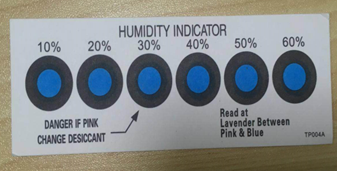
-
- The module needs to be baked in the following cases:
- The packaging bag is damaged before unpacking.
- There is no humidity indicator card (HIC) in the packaging bag.
- After unpacking, circles of 10% and above on the HIC become pink.
- The total exposure time has lasted for over 168 hours since unpacking.
- More than 12 months has passed since sealing of the bag.
- Baking settings:
- Temperature: 60°C and ≤ 5% RH for reel package and 125°C and ≤5% RH for tray package (please use the heat-resistant tray rather than plastic container)
- Time: 48 hours for reel package and 12 hours for tray package
- Alarm temperature: 65°C for reel package and 135°C for tray package
- Production-ready temperature after natural cooling: < 36°C
- Re-baking situation: If a module remains unused for over 168 hours after being baked, it needs to be baked again.
- If a batch of modules is not baked within 168 hours, do not use the reflow soldering or wave soldering to solder them. Because these modules are Level-3 moisture-sensitive devices, they are very likely to get damp when exposed beyond the allowable time. In this case, if they are soldered at high temperatures, it may result in device failure or poor soldering.
- In the whole production process, take electrostatic discharge (ESD) protective measures.
- To guarantee the passing rate, it is recommended that you use the SPI and AOI to monitor the quality of solder paste printing and mounting.
Recommended oven temperature curve
Select a proper soldering manner according to the process. For the SMT process, please refer to the recommended oven temperature curve of reflow soldering. For the wave soldering process, please refer to the recommended oven temperature curve of wave soldering. There are some differences between the set temperatures and the actual temperatures. All the temperatures shown in this module datasheet are obtained through actual measurements.
Manner 1: SMT process (Recommended oven temperature curve of reflow soldering)
Set oven temperatures according to the following curve.
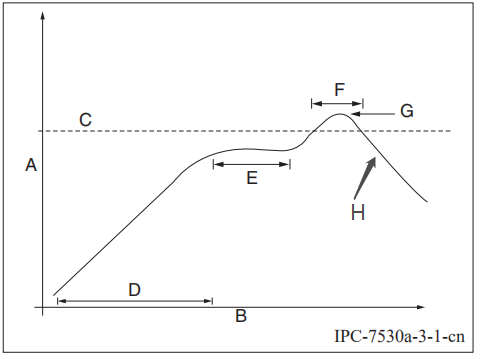
-
A: Temperature axis
-
B: Time axis
-
C: Liquidus temperature: 217 to 220°C
-
D: Ramp-up slope: 1 to 3°C/s
-
E: Duration of constant temperature: 60 to 120s; the range of constant temperature: 150 to 200°C
-
F: Duration above the liquidus: 50 to 70s
-
G: Peak temperature: 235 to 245°C
-
H: Ramp-down slope: 1 to 4°C/s
Note: The above curve is just an example of the solder paste SAC305. For more details about other solder pastes, please refer to Recommended oven temperature curve in the solder paste specifications.
Manner 2: Wave soldering process (Oven temperature curve of wave soldering)
Set oven temperatures according to the following temperature curve of wave soldering. The peak temperature is 260°C±5°C.
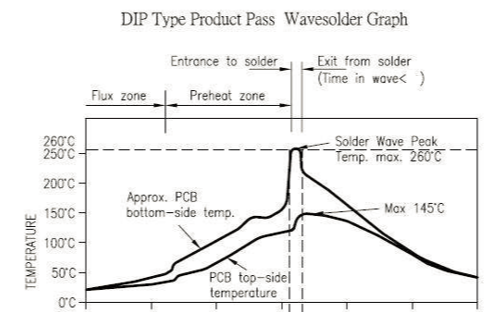
| Suggestions on oven temperature curve of wave soldering | Suggestions on manual soldering temperature | ||
|---|---|---|---|
| Preheat temperature | 80 to 130 °C | Soldering temperature | 360±20°C |
| Preheat time | 75 to 100s | Soldering time | <3s/point |
| Peak contact time | 3 to 5s | NA | NA |
| Temperature of tin cylinder | 260±5°C | NA | NA |
| Ramp-up slope | ≤2°C/s | NA | NA |
| Ramp-down slope | ≤6°C/s | NA | NA |
Storage conditions
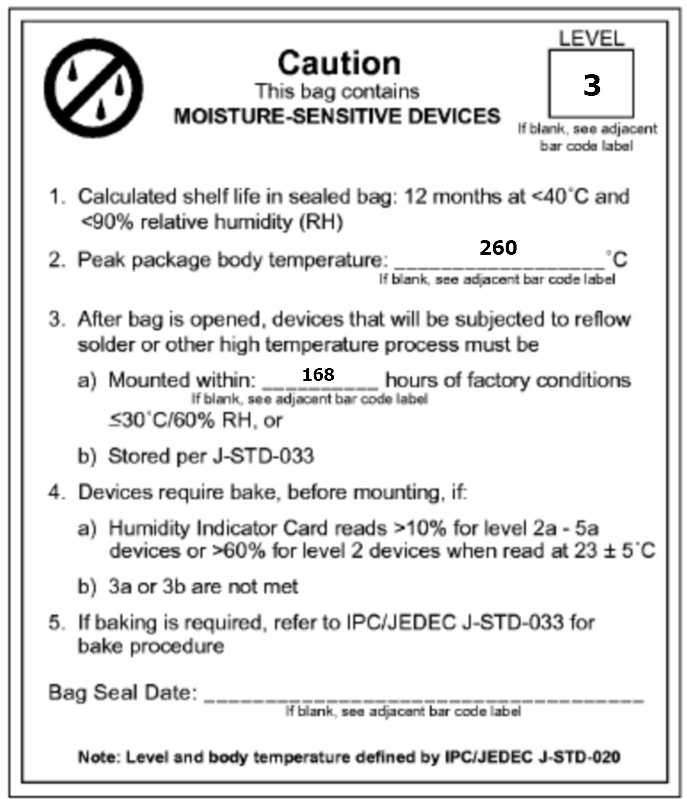
Is this page helpful?
YesFeedbackIs this page helpful?
YesFeedback





